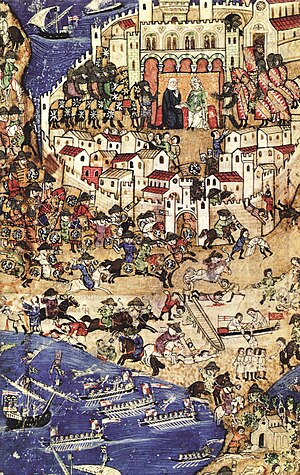Fall of Tripoli (1289)
| Siege of Tripoli (1289) | |||||||||
|---|---|---|---|---|---|---|---|---|---|
| Part of The Crusades | |||||||||
 The siege of Tripoli by the Mamluks in 1289. |
|||||||||
|
|||||||||
| Belligerents | |||||||||
| Bahri Dynasty |
|
||||||||
| Commanders and leaders | |||||||||
|
|
(c.1240-c.1292) Godefroy de Vendac Mathieu de Clermont Amalric of Tyre |
||||||||
The Fall of Tripoli was the capture and destruction of the Crusader state, the County of Tripoli (in what is modern-day Lebanon), by the Muslim Mamluks. The battle occurred in 1289 and was an important event in the Crusades, as it marked the capture of one of the few remaining major possessions of the Crusaders. The event is represented in a rare surviving illustration from a now fragmentary manuscript known as the 'Cocharelli Codex', created in Genoa in the 1330s. The image shows the countess dowager Sibylla of Armenia and Barthélémy Mansel Bishop of Tortosa (granted the apostolic seat in 1278). sitting in state in the centre of the fortified city, and Qalawun's assault in 1289, with his army depicted massacring the inhabitants fleeing to boats in the harbour and to the nearby island of St Thomas.
The County of Tripoli, though founded as a Crusader State and predominantly Christian, had been a vassal state of the Mongol Empire since around 1260, when Bohemond VI, under the influence of his father-in-law Hethum I, King of Armenia, preemptively submitted to the rapidly advancing Mongols. Tripoli had provided troops to the Mongols for the 1258 sack of Baghdad, as well as for the 1260 Mongol invasions of Syria, which caused even further friction with the Muslim world.
After the destruction of Baghdad and the capture of Damascus, which were the centers of the Abbasid and Ayyubid caliphates, by the Khan Hulegu, Islamic power had shifted to the Egyptian Mamluks based in Cairo. Around the same time, the Mongols were slowed in their westward expansion by internal conflicts in their thinly spread Empire. The Mamluks took advantage of this to advance northwards from Egypt, and re-establish dominion over Palestine and Syria, pushing the Ilkhans back into Persia. The Mamluks attempted to take Tripoli in the 1271 siege, but were instead frustrated in their goal by the arrival of Prince Edward in Acre that month. They were persuaded to agree to a truce with both Tripoli and Prince Edward, although his forces had been too small to be truly effective.
...
Wikipedia
